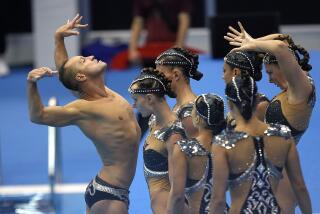AMERICA’S CUP UPDATE : NOTEBOOK : ‘Scuba Cam’ Diver Sorry He Nearly Became a Current Affair
- Share via
SAN DIEGO — Few people have had a closer look at an America’s Cup race from outside a boat than Bob Sloan.
The San Diego-based cameraman was almost run down by Il Moro di Venezia on Friday while working with a “Scuba Cam” for ESPN’s coverage Tuesday when a strong current swept him directly in front of the Italian boat at the first reaching mark.
Sloan estimated the current to be 1 1/2 to 2 knots.
“It felt like a river,” said Sloan, 36. “My first thought was this was exactly what I didn’t want to happen. I was already working my darndest to get out of there.
“The first boat (America 3) was no problem. We’d gotten in the water ahead of time before the boats were even close, just to check out the video system and find out what the water was like. The current was real strong, so judging the wind and the current, I dropped in the water for perfect position for America 3, but I didn’t realize what the current was going to do to me by the time Il Moro came down.
“By (that time) the current had carried me into their path after they made their turn. I got a great shot of America 3, but after Il Moro turned all of a sudden I’m staring at the bow of Il Moro coming right toward me.
“My biggest fear was them cutting me off and me ending up on the other side, because I had my video cable going back to the boat and didn’t want that getting caught up in the keel with me on the other side.”
Il Moro skipper Paul Cayard said he thought about cutting between Sloan and the mark until he saw the cable and decided to go around. Il Moro then put up a protest flag.
“I wasn’t afraid for myself,” Sloan said. “I was more interested in not becoming an issue in the event. I was worried about it until they withdrew their protest. I have a lot of respect for this event and the people involved . . . ever since Dennis (Conner) brought the Cup back from Australia.
“I’ve worked for ESPN ever since then. I don’t just do underwater work. I work as a professional cameraman above the water, also.”
Sloan has his own company, Bob Sloan Productions, and shot ESPN’s “Setting Sail for San Diego” series before the Cup.
“I’m a diver and a cameraman,” Sloan said, “and when I can bring the two together that’s great. I’m glad it’s not an issue. I’m extremely sorry that it did happen.”
One of the men who designed Stars & Stripes, David Pedrick, thinks it’s interesting that America 3’s Bill Koch, who has spent $65 million, suggests the International America’s Cup Class cut costs next time by using cheaper carbon fiber.
“He has wasted so many tens of millions of dollars, saving $100,000 is a flyspeck,” Pedrick said. “He’s had too many people doing way too many things . . . that aren’t productive. Doing what he did could have been done for a fraction of the cost.”
For example, Pedrick said, “We could have built a second boat with an honest $15 million budget.”
That was Dennis Conner’s projected budget. Reality fell about $5 million short.
“With another $1 1/2 million we could have had a second hull,” Pedrick said.
The new hull could have been fitted to the old deck and-- voila!-- a second boat, that might have been just as fast as America 3.
“Talk’s cheap,” Conner said.
Unfortunately for him, boats aren’t.
Until New Zealand lost to Il Moro di Venezia in the challenger finals, most Cup watchers thought the Kiwis had the fastest boat around.
Said Pedrick: “I don’t think the Kiwi boat was a rocket ship. They sailed it very well. For being different, it was very successful.”
New Zealand still hasn’t offered a public look at its tandem keel, but one outsider’s peek at the dismantled appendage this week confirmed that it’s slightly different from what ESPN had been depicting with a drawing.
The fins of the keel aren’t raked but vertical. They are about a foot wide, each with a trim tab-rudder half the width of its fin.
They suspend a flat ballast bulb between them, with no overhang at either end.
At a dinner for the Cup jury this week, with the match tied 1-1, Koch again offered his bet to Il Moro boss Raul Gardini: 1,000 bottles of Chateau Laffite 1982, at about $100 a bottle.
One of the judges, John Ripard of Malta, even had a document drawn up for conditions of the wager, which Koch originally offered Gardini in a race when they would steer their own maxi boats.
Once again Gardini refused.
Marriage vows have curious venues for sports fans, with baseball addicts heading for the diamond, and sailing aficionados heading out to sea.
Using the America’s Cup race course as a backdrop, Rod Pacholzuk and Cynthia Douglas, of Kelowna, Canada, exchanged vows three miles off Point Loma after Tuesday’s race between America 3 and Il Moro di Venezia.
It wasn’t the couple’s first time to San Diego: They were here for the 1988 Cup. This time, with the wedding party assembled on the bow, they were married on Outlaw, a boat owned by Peter Garnes. A reception followed at the Chart House.
Pacholzuk and Tom Ehman, general manager of the America’s Cup Organizing Committee, became good friends while they attended the University of Michigan.


